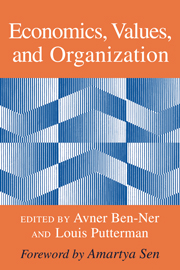Book contents
- Frontmatter
- Contents
- Foreword
- Preface
- List of contributors
- Introduction
- Part I The formation and evolution of social norms and values
- Part II The generation and transmission of values in families and communities
- Part III Social norms and culture
- 10 Social norms as positional arms control agreements
- 11 Bribes and gifts
- 12 How do we know whether a monetary transaction is a gift, an entitlement, or compensation?
- Part IV The organization of work, trust, and incentives
- Part V Markets, values, and welfare
- Epilogue
- Index
12 - How do we know whether a monetary transaction is a gift, an entitlement, or compensation?
Published online by Cambridge University Press: 05 June 2012
- Frontmatter
- Contents
- Foreword
- Preface
- List of contributors
- Introduction
- Part I The formation and evolution of social norms and values
- Part II The generation and transmission of values in families and communities
- Part III Social norms and culture
- 10 Social norms as positional arms control agreements
- 11 Bribes and gifts
- 12 How do we know whether a monetary transaction is a gift, an entitlement, or compensation?
- Part IV The organization of work, trust, and incentives
- Part V Markets, values, and welfare
- Epilogue
- Index
Summary
After millennia during which officially sanctioned monies multiplied but large areas of social life remained outside the zone of monetary exchange, over the last two centuries governments have standardized legal tenders, and the range of monetized social transactions has enormously expanded. These days the highly commercialized economies of Europe are seriously contemplating the imposition of a single money in place of the national currencies that now hold sway in the countries of the European Union. That combination of multiple uses and standardized currency presents living, working social beings with an unrecognized but acute dilemma: how to distinguish unambiguously among forms of payment that have deeply different meanings for their participants. Given the apparent anonymity of bank notes, for example, how do we distinguish among bribes, gifts, tips, allowances, and payments for goods and services?
What is at issue? In my investigation of payment systems, I have found it useful to distinguish among three possible ways of organizing monetary payments of any kind: as compensation (direct exchange), as entitlement (the right to a share), and as gift (one person's voluntary bestowal on another). Money as compensation implies an equal exchange of values, and a certain distance, contingency, bargaining, and accountability among the parties. Money as an entitlement implies strong claims to power and autonomy by the recipient. Money as a gift implies intimacy and/or inequality plus a certain arbitrariness.
What distinguishes such categories of payments? Two elements seem essential: first, the relational content and meaning of the transaction, and second, the time duration of the relation.
- Type
- Chapter
- Information
- Economics, Values, and Organization , pp. 329 - 334Publisher: Cambridge University PressPrint publication year: 1998
- 18
- Cited by



